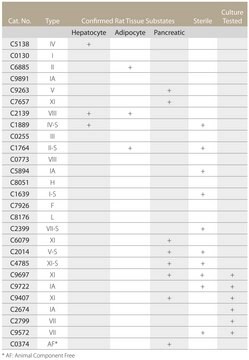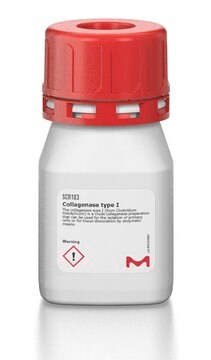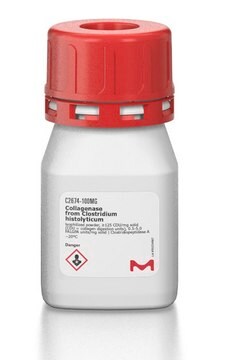C1639
Colagenasa from Clostridium histolyticum
0.2 μm filtered, for general use, Type I-S, 0.2-1.0 FALGPA units/mg solid, ≥125 CDU/mg solid
Sinónimos:
Clostridiopeptidasa A
Iniciar sesiónpara Ver la Fijación de precios por contrato y de la organización
About This Item
Productos recomendados
Quality Level
sterility
0.2 μm filtered
form
lyophilized powder
specific activity
≥125 CDU/mg solid
0.2-1.0 FALGPA units/mg solid
mol wt
68-130 kDa
storage temp.
−20°C
¿Está buscando productos similares? Visita Guía de comparación de productos
Categorías relacionadas
Application
This product is suitable for the disaggregation of human tumor, mouse kidney, human adult and fetal brain, lung and many other epithelia tissues. It has also been shown to be effective in liver and kidney perfusion studies, digestion of pancreas, isolation of nonparenchymal rat liver cells and hepatocyte preparation. Collagenase has also been used in the preparation of arterial tissue for the study of Advanced Glycosylation End Products. This enzyme has been tested for the release of heptatocytes at a concentration of approximately 1 mg/mL. Concentrations for digestion range from 0.1 to 5 mg/mL.
Biochem/physiol Actions
La colagenasa es activada por cuatro átomo-gramos de calcio por mol de enzima. Es inhibida por el ácido etilenglicol-bis(beta-aminoetil éter) - N, N, N′,N′-tetraacético, el beta-mercaptoetanol, el glutatión, el ácido tioglicólico y la 8-hidroxiquinolina.
The collagenase product is a mixture of enzymes secreted by C. histolyticum, with different products differentiated by the relative ratios of the 10-18 components found in the secreted enzymes. The main components are two collagenases, clostripain, and a neutral protease. The synergistic action of these enzymes degrade collagen and other intracellular materialThe action of both collagenase enzymes and the neutral protease is necessary for effective release of cells from tissue. Various types of collagen are the natural substrates for collagenase.
Caution
As supplied, this product is stable for one year at -20°C. There is no loss in FALGPA or protease activity in 30 days at 37°C, 50°C and -20°C. Solutions of crude collagenase are stable if frozen quickly in aliquots (at 10 mg/mL) and kept frozen at -20°C. Further freeze-thaw cycles will damage the solution. The product retains 100% activity over 7 hours when held on ice.
Unit Definition
Una unidad de digestión de colágeno (CDU) libera péptidos del colágeno del tendón de Aquiles bovino que equivalen en la reacción de color de la ninhidrina a 1,0 μmoles de leucina en 5 horas a pH 7,4 y 37 °C en presencia de iones calcio. Una unidad de hidrólisis FALGPA hidroliza 1,0 μmoles de furilacriloil-Leu-Gly-Pro-Ala por minuto a 25°C. Una unidad de proteasa neutra hidroliza la caseína para producir color equivalente a 1,0 μmoles de tirosina por 5 horas a pH 7,5 y 37°C. Una unidad de clostripaína hidroliza 1,0 μmoles de BAEE por minuto a pH 7,6 y 25°C en presencia de DTT.
Preparation Note
Prepared from Type I (C0130). A stock solution may be prepared by dissolving 0.05-0.1 mg/mL of collagenase in 50 mM TES buffer containing 0.36 mM calcium chloride (TESCA, pH 7.4) at 37 °C.
substrate
Referencia del producto
Descripción
Precios
signalword
Danger
hcodes
Hazard Classifications
Eye Irrit. 2 - Resp. Sens. 1 - Skin Irrit. 2 - STOT SE 3
target_organs
Respiratory system
Storage Class
11 - Combustible Solids
wgk_germany
WGK 1
flash_point_f
Not applicable
flash_point_c
Not applicable
ppe
dust mask type N95 (US), Eyeshields, Faceshields, Gloves
Elija entre una de las versiones más recientes:
¿Ya tiene este producto?
Encuentre la documentación para los productos que ha comprado recientemente en la Biblioteca de documentos.
Los clientes también vieron
FAM71F1 binds to RAB2A and RAB2B and is essential for acrosome formation and male fertility in mice.
Akane Morohoshi et al.
Development (Cambridge, England), 148(21) (2021-10-30)
The acrosome is a cap-shaped, Golgi-derived membranous organelle that is located over the anterior of the sperm nucleus and highly conserved throughout evolution. Although morphological changes during acrosome biogenesis in spermatogenesis have been well described, the molecular mechanism underlying this
Cuiping Zhang et al.
Cell death & disease, 11(6), 470-470 (2020-06-20)
Mesenchymal stem cells (MSCs) have been used in cell-based therapies for a variety of disorders. Some factors such as inflammatory mediators in the diseased area might damage the survival of MSCs and affect their efficacy. Pyroptosis is a form of
Tony Schountz et al.
Viruses, 11(3) (2019-03-27)
Syrian hamsters (Mesocricetus auratus) are a pathogenesis model for the Nipah virus (NiV), and we sought to determine if they are also susceptible to the Cedar virus (CedPV). Following intranasal inoculation with CedPV, virus replication occurred in the lungs and
Hyunji Byun et al.
Reproductive biology and endocrinology : RB&E, 19(1), 112-112 (2021-07-18)
The tumor susceptibility gene 101 (Tsg101), a component of the endosomal sorting complex required for transport (ESCRT) complex I, is involved in multiple biological processes involving endomembranous structures and the plasma membrane. The role of Tsg101 in the uterine epithelium
Ralph Stadhouders et al.
Nature protocols, 8(3), 509-524 (2013-02-16)
Chromosome conformation capture (3C) technology is a powerful and increasingly popular tool for analyzing the spatial organization of genomes. Several 3C variants have been developed (e.g., 4C, 5C, ChIA-PET, Hi-C), allowing large-scale mapping of long-range genomic interactions. Here we describe
Nuestro equipo de científicos tiene experiencia en todas las áreas de investigación: Ciencias de la vida, Ciencia de los materiales, Síntesis química, Cromatografía, Analítica y muchas otras.
Póngase en contacto con el Servicio técnico






